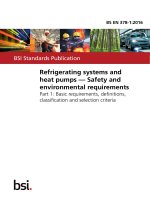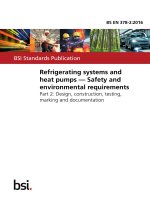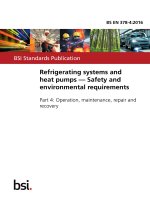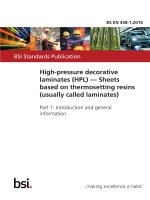Bsi bs en 62264 4 2016
Bạn đang xem bản rút gọn của tài liệu. Xem và tải ngay bản đầy đủ của tài liệu tại đây (3.84 MB, 94 trang )
BS EN 62264-4:2016
BSI Standards Publication
Enterprise-control system
integration
Part 4: Object model attributes for
manufacturing operations management
integration
BS EN 62264-4:2016 BRITISH STANDARD
National foreword
This British Standard is the UK implementation of EN 62264-4:2016. It is
identical to IEC 62264-4:2015.
The UK participation in its preparation was entrusted to Technical
Committee AMT/7, Industrial communications: process measurement and
control, including fieldbus.
A list of organizations represented on this committee can be obtained on
request to its secretary.
This publication does not purport to include all the necessary provisions of
a contract. Users are responsible for its correct application.
© The British Standards Institution 2016.
Published by BSI Standards Limited 2016
ISBN 978 0 580 85614 3
ICS 25.040.99; 35.100.05; 35.200.50
Compliance with a British Standard cannot confer immunity from
legal obligations.
This British Standard was published under the authority of the
Standards Policy and Strategy Committee on 30 April 2016.
Amendments/corrigenda issued since publication
Date Text affected
EUROPEAN STANDARD BS EN 62264-4:2016
NORME EUROPÉENNE
EUROPÄISCHE NORM EN 62264-4
ICS 25.040.99; 35.100.05; 35.200 April 2016
English Version
Enterprise-control system integration - Part 4: Object model
attributes for manufacturing operations management integration
(IEC 62264-4:2015)
Intégration des systèmes entreprise-contrôle - Partie 4: Integration von Unternehmensführungs- und Leitsystemen -
Attributs des modèles d'objets pour l'intégration de la Teil 4: Attribute des Objektmodells für die Integration des
operativen Produktionsmanagements
gestion des opérations de fabrication (IEC 62264-4:2015)
(IEC 62264-4:2015)
This European Standard was approved by CENELEC on 2016-01-20. CENELEC members are bound to comply with the CEN/CENELEC
Internal Regulations which stipulate the conditions for giving this European Standard the status of a national standard without any alteration.
Up-to-date lists and bibliographical references concerning such national standards may be obtained on application to the CEN-CENELEC
Management Centre or to any CENELEC member.
This European Standard exists in three official versions (English, French, German). A version in any other language made by translation
under the responsibility of a CENELEC member into its own language and notified to the CEN-CENELEC Management Centre has the
same status as the official versions.
CENELEC members are the national electrotechnical committees of Austria, Belgium, Bulgaria, Croatia, Cyprus, the Czech Republic,
Denmark, Estonia, Finland, Former Yugoslav Republic of Macedonia, France, Germany, Greece, Hungary, Iceland, Ireland, Italy, Latvia,
Lithuania, Luxembourg, Malta, the Netherlands, Norway, Poland, Portugal, Romania, Slovakia, Slovenia, Spain, Sweden, Switzerland,
Turkey and the United Kingdom.
European Committee for Electrotechnical Standardization
Comité Européen de Normalisation Electrotechnique
Europäisches Komitee für Elektrotechnische Normung
CEN-CENELEC Management Centre: Avenue Marnix 17, B-1000 Brussels
© 2016 CENELEC All rights of exploitation in any form and by any means reserved worldwide for CENELEC Members.
Ref. No. EN 62264-4:2016 E
BS EN 62264-4:2016
EN 62264-4:2016
European foreword
The text of document 65E/479/FDIS, future edition 1 of IEC 62264-4, prepared by SC 65E "Devices
and integration in enterprise systems", of IEC/TC 65 "Industrial-process measurement, control and
automation" was submitted to the IEC-CENELEC parallel vote and approved by CENELEC as
EN 62264-4:2016.
The following dates are fixed: (dop) 2016-10-20
(dow) 2019-01-20
• latest date by which the document has to be implemented at
national level by publication of an identical national
standard or by endorsement
• latest date by which the national standards conflicting with
the document have to be withdrawn
Attention is drawn to the possibility that some of the elements of this document may be the subject of
patent rights. CENELEC [and/or CEN] shall not be held responsible for identifying any or all such
patent rights.
Endorsement notice
The text of the International Standard IEC 62264-4:2015 was approved by CENELEC as a European
Standard without any modification.
In the official version, for Bibliography, the following notes have to be added for the standards indicated:
IEC 61512 (series) NOTE Harmonized as EN 61512 (series).
IEC 62541 (series) NOTE Harmonized as EN 62541 (series).
2
BS EN 62264-4:2016
EN 62264-4:2016
Annex ZA
(normative)
Normative references to international publications
with their corresponding European publications
The following documents, in whole or in part, are normatively referenced in this document and are
indispensable for its application. For dated references, only the edition cited applies. For undated
references, the latest edition of the referenced document (including any amendments) applies.
NOTE 1 When an International Publication has been modified by common modifications, indicated by (mod), the relevant
EN/HD applies.
NOTE 2 Up-to-date information on the latest versions of the European Standards listed in this annex is available here:
www.cenelec.eu.
Publication Year Title EN/HD Year
IEC 61511-1 - -
Functional safety - Safety instrumented-
2010
systems for the process industry sector - 2013
2013
Normative (uon) -- Part 1: Framework, -
-
definitions, system, hardware and software -
-
requirements -
IEC 61512-4 2009 Batch control -- Part 4: Batch productionEN 61512-4 -
IEC 62264-1 2013
IEC 62264-2 2013 records
Enterprise-control system integration --EN 62264-1
Part 1: Models and terminology
Enterprise-control system integration --EN 62264-2
Part 2: Object and attributes for enterprise-
control system integration
IEC 62264-3 - Enterprise-control system integration --EN 62264-3
Part 3 Activity models of manufacturing
operations management
IEC 62682 - Management of Alarm Systems for theEN 62682
Process Industries
ISO 8601 - Data elements and interchange formats --
Information interchange - Representation
of dates and times
ISO/IEC 19501 - Information technology - Open Distributed-
Processing - Unified Modeling Language
(UML) Version 1.4.2
ISO/IEC 19505-1 - Information technology - Object-
Management Group Unified Modeling
Language (OMG UML) - Part 1:
Infrastructure
ISO/IEC 19505-2 - Information technology - Object-
Management Group Unified Modeling
Language (OMG UML) – Part 2:
Superstructure
3
– 2 – BS EN 62264-4:2016
IEC 62264-4:2015 © IEC 2015
CONTENTS
FOREW ORD ........................................................................................................................... 8
INTRODUCTION................................................................................................................... 10
1 Scope ............................................................................................................................ 11
2 Normative references .................................................................................................... 11
3 Terms, definitions, abbreviations and conventions .........................................................11
3.1 Terms and definitions............................................................................................11
3.2 Symbols and abbreviations ................................................................................... 13
3.3 Conventions.......................................................................................................... 14
4 Information exchange between manufacturing operations ..............................................14
4.1 Activity information exchange network ..................................................................14
4.2 Information exchange models ...............................................................................15
4.2.1 Overview ....................................................................................................... 15
4.2.2 Process segments and work masters .............................................................15
4.2.3 Common resource definitions ........................................................................15
4.2.4 Work models.................................................................................................. 15
5 Object model representation .......................................................................................... 16
5.1 Minimum attribute sets .......................................................................................... 16
5.2 Attribute extensibility.............................................................................................16
5.3 Object model structure .......................................................................................... 16
5.4 Conventions used in table of attributes .................................................................17
5.4.1 Attribute table elements .................................................................................17
5.4.2 Object identification ....................................................................................... 18
5.4.3 Data types of attributes.................................................................................. 18
5.4.4 Value types ................................................................................................... 18
5.4.5 Presentation of examples ..............................................................................18
5.4.6 References to resources ................................................................................ 19
6 Resource relationship network model ............................................................................19
6.1 Resource relationship network .............................................................................. 19
6.2 Resource relationship network attributes...............................................................20
6.3 Resource network connection ............................................................................... 21
6.4 Resource network connection property .................................................................22
6.5 From resource reference.......................................................................................22
6.6 From resource reference property .........................................................................23
6.7 To resource reference...........................................................................................23
6.8 To resource reference property .............................................................................24
6.9 Resource network connection type........................................................................ 25
6.10 Resource network connection type property .......................................................... 25
7 Work definition model .................................................................................................... 25
7.1 Work definition ...................................................................................................... 25
7.2 Work master ......................................................................................................... 26
7.3 Work directive ....................................................................................................... 26
7.4 Work definition attributes ...................................................................................... 27
7.5 Parameter specification ........................................................................................ 28
7.6 Personnel specification ......................................................................................... 28
7.7 Personnel specification property ...........................................................................28
BS EN 62264-4:2016 – 3 –
IEC 62264-4:2015 © IEC 2015
7.8 Equipment specification ........................................................................................ 29
7.9 Equipment specification property ..........................................................................29
7.10 Physical asset specification .................................................................................. 29
7.11 Physical asset specification property..................................................................... 29
7.12 Material specification ............................................................................................ 29
7.13 Material specification property ..............................................................................29
7.14 Workflow specification .......................................................................................... 29
7.14.1 Workflow specification model......................................................................... 29
7.14.2 Workflow specification attributes.................................................................... 31
7.14.3 Workflow specification node .......................................................................... 32
7.14.4 Workflow specification node property............................................................. 32
7.14.5 Workflow specification connection ................................................................. 32
7.14.6 Workflow specification connection property ...................................................33
7.14.7 Workflow specification node type ................................................................... 33
7.14.8 Workflow specification node type property ..................................................... 33
7.14.9 Workflow specification connection type.......................................................... 34
7.14.10 Workflow specification connection type property ............................................34
8 Work schedule and job list models................................................................................. 35
8.1 Work schedule ...................................................................................................... 35
8.2 Work schedule attributes....................................................................................... 37
8.3 Work request attributes ......................................................................................... 38
8.4 Job list definition ................................................................................................... 39
8.5 Job list attributes .................................................................................................. 40
8.6 Job order attributes...............................................................................................40
8.7 Job order parameter ............................................................................................. 42
8.8 Personnel requirement .......................................................................................... 42
8.9 Personnel requirement property ............................................................................42
8.10 Equipment requirement ......................................................................................... 42
8.11 Equipment requirement property ...........................................................................42
8.12 Physical asset requirement ................................................................................... 42
8.13 Physical asset requirement property ..................................................................... 42
8.14 Material requirement ............................................................................................. 42
8.15 Material requirement property ...............................................................................42
8.16 Job order to work master relationship ...................................................................42
9 Work performance model ............................................................................................... 43
9.1 Work performance ................................................................................................ 43
9.2 Work performance attributes ................................................................................. 44
9.3 Work response...................................................................................................... 45
9.4 Job response list................................................................................................... 46
9.5 Job response ........................................................................................................ 47
9.6 Job response data ................................................................................................ 47
9.7 Personnel actual ................................................................................................... 47
9.8 Personnel actual property ..................................................................................... 48
9.9 Equipment actual .................................................................................................. 48
9.10 Equipment actual property .................................................................................... 48
9.11 Physical asset actual ............................................................................................ 48
9.12 Physical asset actual property .............................................................................. 48
9.13 Material actual ...................................................................................................... 48
9.14 Material actual property ........................................................................................ 48
– 4 – BS EN 62264-4:2016
IEC 62264-4:2015 © IEC 2015
10 Work capability model.................................................................................................... 48
10.1 Work capability ..................................................................................................... 48
10.2 Work capability attributes ...................................................................................... 49
10.3 Personnel capability..............................................................................................50
10.4 Personnel capability property ................................................................................50
10.5 Equipment capability.............................................................................................50
10.6 Equipment capability property ...............................................................................51
10.7 Physical asset capability ....................................................................................... 51
10.8 Physical asset capability property ......................................................................... 51
10.9 Material capability ................................................................................................. 51
10.10 Material capability property ...................................................................................51
11 Work master capability model ........................................................................................ 51
11.1 Work master capability.......................................................................................... 51
11.2 Work master capability attributes .......................................................................... 52
11.3 Personnel capability..............................................................................................53
11.4 Personnel capability property ................................................................................53
11.5 Equipment capability.............................................................................................53
11.6 Equipment capability property ...............................................................................54
11.7 Physical asset capability ....................................................................................... 54
11.8 Physical asset capability property ......................................................................... 54
11.9 Material capability ................................................................................................. 54
11.10 Material capability property ...................................................................................54
12 Work KPI model............................................................................................................. 54
13 Work alert model ........................................................................................................... 54
13.1 Work alert ............................................................................................................. 54
13.2 Work alert definition .............................................................................................. 55
13.3 Work alert definition property ................................................................................ 55
13.4 Work alert attributes.............................................................................................. 56
13.5 Work alert property ............................................................................................... 57
14 Work calendar model ..................................................................................................... 57
14.1 Work calendar definition and work calendar ..........................................................57
14.2 Work calendar definition ....................................................................................... 58
14.3 Work calendar definition entry............................................................................... 59
14.4 Work calendar definition entry property ................................................................. 60
14.5 Work calendar....................................................................................................... 60
14.6 Work calendar entry.............................................................................................. 60
14.7 Work calendar entry property ................................................................................ 61
15 Work documents............................................................................................................ 61
16 Work record model ........................................................................................................ 62
16.1 Work record definition ........................................................................................... 62
16.2 Work record .......................................................................................................... 63
16.3 Work record extensions ........................................................................................ 63
16.4 Work record model................................................................................................ 65
16.5 Work record entry ................................................................................................. 66
16.6 Work record container objects............................................................................... 67
16.7 Event types and subtypes ..................................................................................... 67
17 Object lists and relationships ......................................................................................... 68
18 Compliance ................................................................................................................... 71
BS EN 62264-4:2016 – 5 –
IEC 62264-4:2015 © IEC 2015
Annex A (informative) Questions and answers about object use ..........................................72
A.1 How are dependencies in the work schedule and work response handled? ...........72
A.2 What are examples of resource relationships? ......................................................72
Annex B (informative) Related standards .............................................................................75
Annex C (informative) Representing a workflow specification in BPMN ................................77
Annex D (informative) Representing a workflow specification in flowchart notation...............81
Annex E (informative) Example of work calendars................................................................83
E.1 Four-day 24-hour shift pattern...............................................................................83
E.2 Example of ISO 8601 format strings ......................................................................85
E.3 Bank holiday work calendar ..................................................................................85
Bibliography.......................................................................................................................... 87
Figure 1 – Information exchange models for manufacturing operations management ...........14
Figure 2 – Resource relationship network model ...................................................................20
Figure 3 – Work definition model........................................................................................... 26
Figure 4 – Relationship of work master to work directive.......................................................27
Figure 5 – Workflow specification model ...............................................................................30
Figure 6 – Example of a workflow specification in BPMN format............................................30
Figure 7 – Example of a workflow specification in flowchart format .......................................31
Figure 8 – Work schedule model ........................................................................................... 35
Figure 9 – Operations schedule for a site..............................................................................36
Figure 10 – Work schedule for an area .................................................................................36
Figure 11 – Work request, job order, job list..........................................................................37
Figure 12 – Work request example for continuous processing ...............................................37
Figure 13 – Example of job orders and work master relationships .........................................43
Figure 14 – Work performance model ...................................................................................44
Figure 15 – Work capability model ........................................................................................ 49
Figure 16 – Work master capability object model ..................................................................52
Figure 17 – Work alert model ................................................................................................ 55
Figure 18 – Work calendar model ......................................................................................... 58
Figure 19 – Work record environment ...................................................................................63
Figure 20 – Work record container example ..........................................................................64
Figure 21 – Work record element reference example ............................................................65
Figure 22 – Work record model ............................................................................................. 66
Figure 23 – Relationship between models .............................................................................69
Figure A.1 – Equipment resources ........................................................................................ 73
Figure A.2 – Routing relationship network ............................................................................. 73
Figure A.3 – Gas main relationship network ..........................................................................74
Figure A.4 – “Usable in” relationship network ........................................................................ 74
Figure B.1 – Relationship to IEC 62264-2 and IEC 61512 standards .....................................76
Figure C.1 – Example of a workflow specification in BPMN notation......................................79
Figure C.2 – Example workflow process in the workflow specification model .........................80
Figure D.1 – Example of a workflow specification in flowchart notation .................................81
Figure D.2 – Example workflow process in the workflow specification model .........................82
– 6 – BS EN 62264-4:2016
IEC 62264-4:2015 © IEC 2015
Table 1 – UML notation used ................................................................................................ 17
Table 2 – Example table ....................................................................................................... 18
Table 3 – Resource relationship network attributes ...............................................................21
Table 4 – Resource network connection attributes ................................................................21
Table 5 – Resource network connection property attributes ..................................................22
Table 6 – From resource reference attributes........................................................................23
Table 7 – From resource reference property attributes ..........................................................23
Table 8 – To resource reference attributes............................................................................24
Table 9 – To resource reference property attributes ..............................................................24
Table 10 – Resource network connection type attributes....................................................... 25
Table 11 – Resource network connection type property attributes .........................................25
Table 12 – Additional attributes of material specification .......................................................27
Table 13 – Work definition attributes ..................................................................................... 28
Table 14 – Workflow specification attributes .........................................................................31
Table 15 – Workflow specification node attributes.................................................................32
Table 16 – Workflow specification node property attributes ...................................................32
Table 17 – Workflow specification connection attributes........................................................33
Table 18 – Workflow specification connection property attributes ..........................................33
Table 19 – Workflow specification node type attributes ......................................................... 33
Table 20 – Workflow specification node type property attributes ...........................................34
Table 21 – Workflow specification connection type attributes ................................................ 34
Table 22 – Workflow specification connection property attributes ..........................................34
Table 23 – Work schedule attributes ..................................................................................... 38
Table 24 – Work request attributes ....................................................................................... 39
Table 25 – Job list attributes ................................................................................................. 40
Table 26 – Job order attributes ............................................................................................. 41
Table 27 – Work performance attributes ...............................................................................45
Table 28 – Work response attributes..................................................................................... 46
Table 29 – Job response list attributes..................................................................................46
Table 30 – Job response attributes ....................................................................................... 47
Table 31 – Work capability attributes .................................................................................... 50
Table 32 – Work master capability attributes.........................................................................53
Table 33 – Work alert definition attributes .............................................................................55
Table 34 – Work alert definition property attributes ...............................................................56
Table 35 – Examples of work alert properties........................................................................56
Table 36 – Work alert attributes ............................................................................................ 57
Table 37 – Work alert property attributes ..............................................................................57
Table 38 – Work calendar definition attributes ......................................................................59
Table 39 – Work calendar definition entry attributes..............................................................59
Table 40 – Work calendar definition entry property attributes ................................................60
Table 41 – Work calendar attributes...................................................................................... 60
Table 42 – Work calendar entry attributes .............................................................................61
BS EN 62264-4:2016 – 7 –
IEC 62264-4:2015 © IEC 2015
Table 43 – Work calendar entry property attributes ...............................................................61
Table 44 – Work record entry attributes ................................................................................67
Table 45 – Additional event types and subtypes.................................................................... 68
Table 46 – Objects and models.............................................................................................70
Table E.1 – Four-day 24-hour shift pattern example..............................................................83
Table E.2 – Work calendar definition for 4-day 24–hour shift entry examples ........................83
Table E.3 – Work calendar definition entry for 4-day 24–hour shift example..........................84
Table E.4 – Work calendar entries for 2014 shift calendar ....................................................85
Table E.5 – Work calendar definition for 2014 England bank holidays ...................................85
Table E.6 – Work calendar definition entries for 2014 England bank holidays .......................86
– 8 – BS EN 62264-4:2016
IEC 62264-4:2015 © IEC 2015
INTERNATIONAL ELECTROTECHNICAL COMMISSION
____________
ENTERPRISE-CONTROL SYSTEM INTEGRATION –
Part 4: Object model attributes for manufacturing
operations management integration
FOREWORD
1) The International Electrotechnical Commission (IEC) is a worldwide organization for standardization comprising
all national electrotechnical committees (IEC National Committees). The object of IEC is to promote
international co-operation on all questions concerning standardization in the electrical and electronic fields. To
this end and in addition to other activities, IEC publishes International Standards, Technical Specifications,
Technical Reports, Publicly Available Specifications (PAS) and Guides (hereafter referred to as “IEC
Publication(s)”). Their preparation is entrusted to technical committees; any IEC National Committee interested
in the subject dealt with may participate in this preparatory work. International, governmental and non-
governmental organizations liaising with the IEC also participate in this preparation. IEC collaborates closely
with the International Organization for Standardization (ISO) in accordance with conditions determined by
agreement between the two organizations.
2) The formal decisions or agreements of IEC on technical matters express, as nearly as possible, an international
consensus of opinion on the relevant subjects since each technical committee has representation from all
interested IEC National Committees.
3) IEC Publications have the form of recommendations for international use and are accepted by IEC National
Committees in that sense. While all reasonable efforts are made to ensure that the technical content of IEC
Publications is accurate, IEC cannot be held responsible for the way in which they are used or for any
misinterpretation by any end user.
4) In order to promote international uniformity, IEC National Committees undertake to apply IEC Publications
transparently to the maximum extent possible in their national and regional publications. Any divergence
between any IEC Publication and the corresponding national or regional publication shall be clearly indicated in
the latter.
5) IEC itself does not provide any attestation of conformity. Independent certification bodies provide conformity
assessment services and, in some areas, access to IEC marks of conformity. IEC is not responsible for any
services carried out by independent certification bodies.
6) All users should ensure that they have the latest edition of this publication.
7) No liability shall attach to IEC or its directors, employees, servants or agents including individual experts and
members of its technical committees and IEC National Committees for any personal injury, property damage or
other damage of any nature whatsoever, whether direct or indirect, or for costs (including legal fees) and
expenses arising out of the publication, use of, or reliance upon, this IEC Publication or any other IEC
Publications.
8) Attention is drawn to the Normative references cited in this publication. Use of the referenced publications is
indispensable for the correct application of this publication.
9) Attention is drawn to the possibility that some of the elements of this IEC Publication may be the subject of
patent rights. IEC shall not be held responsible for identifying any or all such patent rights.
International Standard IEC 62264-4 has been prepared by subcommittee 65E: Devices and
integration in enterprise systems, of IEC technical committee 65: Industrial-process
measurement, control and automation.
The text of this standard is based on the following documents:
FDIS Report on voting
65E/479/FDIS 65E/488/RVD
Full information on the voting for the approval of this standard can be found in the report on
voting indicated in the above table.
This publication has been drafted in accordance with the ISO/IEC Directives, Part 2.
BS EN 62264-4:2016 – 9 –
IEC 62264-4:2015 © IEC 2015
A list of all parts in the IEC 62264 series, published under the general title Enterprise-control
system integration, can be found on the IEC website.
The committee has decided that the contents of this publication will remain unchanged until
the stability date indicated on the IEC website under "" in the data
related to the specific publication. At this date, the publication will be
• reconfirmed,
• withdrawn,
• replaced by a revised edition, or
• amended.
IMPORTANT – The 'colour inside' logo on the cover page of this publication indicates
that it contains colours which are considered to be useful for the correct
understanding of its contents. Users should therefore print this document using a
colour printer.
– 10 – BS EN 62264-4:2016
IEC 62264-4:2015 © IEC 2015
INTRODUCTION
This part of IEC 62264 defines the interfaces between enterprise activities and control
activities and is to be used in conjunction with IEC 62264-3.
The scope of this part of IEC 62264 is limited to defining the details of the information content
of interfaces within manufacturing operations management. The scope is limited to the
definition of object models and attributes for the information defined in IEC 62264-3. The goal
is to reduce the effort, cost, and errors associated with implementing these interfaces.
The standard may be used to reduce the effort associated with implementing new product
offerings. The goal is to have enterprise systems and control systems that interoperate and
easily integrate.
This part of IEC 62264 further defines the object models and attributes involved in data
exchange between activities of manufacturing operations management defined in 62264-3.
The models and terminology defined in IEC 62264-3 and this part of IEC 6226
a) emphasize good manufacturing operations management integration practices during the
entire life cycle of the systems;
b) can be used to improve existing integration capability of manufacturing operations
management systems; and
c) can be applied regardless of the degree of automation.
Specifically, IEC 62264-3 and this part of IEC 62264 provide a standard terminology and a
consistent set of concepts and models for integrating manufacturing operations management
systems that will improve communications between all parties involved. Benefits produced will
d) reduce the user’s time to reach full production levels for new products;
e) enable vendors to supply appropriate tools for implementing integration of manufacturing
operations management systems;
f) enable users to better identify their needs;
g) reduce the cost of automating manufacturing processes;
h) optimize supply chains; and
i) reduce life-cycle engineering efforts.
IEC 62264-3 and this part of IEC 62264 may be used to reduce the effort associated with
implementing new product offerings. The goal is to have manufacturing operations
management systems that interoperate and easily integrate.
It is not the intent of the standards to
1) suggest that there is only one way of implementing integration of manufacturing
operations management systems;
2) force users to abandon their current way of handling integration; or
3) restrict development in the area of integration of manufacturing operations management
systems.
BS EN 62264-4:2016 – 11 –
IEC 62264-4:2015 © IEC 2015
ENTERPRISE-CONTROL SYSTEM INTEGRATION –
Part 4: Object model attributes for manufacturing
operations management integration
1 Scope
This part defines object models and attributes exchanged between Level 3 manufacturing
operations management activities defined in IEC 62264-3.
2 Normative references
The following documents, in whole or in part, are normatively referenced in this document and
are indispensable for its application. For dated references, only the edition cited applies. For
undated references, the latest edition of the referenced document (including any
amendments) applies.
IEC 62264-1:2013, Enterprise-control system integration – Part 1: Models and terminology
IEC 62264-2:2013, Enterprise-control system integration – Part 2: Object and attributes for
enterprise-control system integration
IEC 62264-3, Enterprise-control system integration – Part 3: Activity models of manufacturing
operations management
IEC 61512-1, Batch control – Part 1: Models and terminology
IEC 61512-4:2009, Batch control – Part 4: Batch production records
IEC 62682, Management of alarm systems for the process industries
ISO/IEC 19501, Information technology – Open Distributed Processing – Unified Modeling
Language (UML) Version 1.4.2
ISO/IEC 19505-1, Information technology – Object Management Group Unified Modeling
Language (OMG UML) – Part 1: Infrastructure
ISO/IEC 19505-2, Information technology – Object Management Group Unified Modeling
Language (OMG UML) – Part 2: Superstructure
ISO 8601, Data elements and interchange formats – Information interchange –
Representation of dates and times
3 Terms, definitions, abbreviations and conventions
3.1 Terms and definitions
For the purposes of this document the terms and definitions given in IEC 62264-1 as well as
the following apply.
– 12 – BS EN 62264-4:2016
IEC 62264-4:2015 © IEC 2015
3.1.1 based upon business
batch production record
BPR
subset of the execution and business information that is retained
requirements identified by the batch production record specification
Note 1 to entry: This note applies to the French language only.
[SOURCE: IEC 61512-4:2009, 3.2]
3.1.2
job list
collection of job orders for one or more work centers and/or resources for a specific time
frame
3.1.3
job order
unit of scheduled work that is dispatched for execution
3.1.4
job response
information on the result of execution of a job order
3.1.5
job response list
collection of job responses for one or more work centers and/or resources for a specific time
frame
3.1.6
resource relationship network
one or more expressions of a relationship between two or more resources
3.1.7
work alert
notification of a Level 3 event that does not require acknowledgement
3.1.8
work calendar
collection of work calendar entries
3.1.9
work calendar entry
information about a specific time period
3.1.10
work capability
collection of information about the resources for work for selected future and past times
3.1.11
work definition
collection of information about resources and workflow specification associated with job
orders
3.1.12
work directive
type of work definition derived from a work master and used to perform a specific job order
BS EN 62264-4:2016 – 13 –
IEC 62264-4:2015 © IEC 2015
3.1.13
work KPI
key performance indicator related to Level 3 activities
3.1.14
work master
type of work definition that is a template for work to be performed for a job order
3.1.15
work performance
collection of work responses
Note 1 to entry: This note applies to the French language only.
3.1.16
work master capability
collection of information about the resources for selected future and past times for a specific
work master
3.1.17
work record
subset of the execution and business information that is retained based upon business
requirements
3.1.18
work request
collection of job orders
3.1.19
work response
collection of job responses
3.1.20
work schedule
detailed schedule of MOM activities as a collection of work requests
3.1.21
workflow specification
information representing work as a pattern of activities used to orchestrate the execution of
procedures
EXAMPLE A repeatable sequence of procedures, enabled by an organization of resources with defined roles
corresponding to flows of mass, energy or information.
3.2 Symbols and abbreviations
BPMN Business Process Model and Notation
BPR Batch production record
ERP Enterprise resource planning
ID Identifier
KPI Key performance indicator
MES Manufacturing execution system
MOM Manufacturing operations management
SOP Standard operating procedures
UML Unified Modeling Language
UTC Coordinated Universal Time
– 14 – BS EN 62264-4:2016
IEC 62264-4:2015 © IEC 2015
3.3 Conventions
Italics are used, beyond the use defined in ISO/IEC Directives Part2, to emphasize the 62264
specific meaning of terminology. They are used for the following cases:
– Names of objects used in exchanged data
4 Information exchange between manufacturing operations
4.1 Activity information exchange network
A set of models are used to represent the information exchanged between activities defined in
IEC 62264-3. This is illustrated in Figure 1 with each information model represented as black
rounded rectangles. This part of IEC 62264 defines models of information which can be
exchanged between Level 3 activities (represented as ellipses in the figure) within an
operational category or across operational categories. IEC 62264-2 defines models of
information that may be exchanged between Level 4 activities and Level 3 activities and are
represented as yellow rounded rectangles. Other information (represented as hashed
elements) shown in Figure 1 is defined in other standards, such as IEC 61512 and IEC 62541.
IEC
Figure 1 – Information exchange models
for manufacturing operations management
NOTE IEC 61512 defines object models that relate to the lower elements of the Level 3 activities and defines the
information used to create and manage master recipes, control recipes, batch lists, and batch production records.
Equivalent structures, or IEC 61512 structures, could be used for other types of production. This standard does not
redefine these objects.
BS EN 62264-4:2016 – 15 –
IEC 62264-4:2015 © IEC 2015
4.2 Information exchange models
4.2.1 Overview
The information exchange models define structures that can be used to define, manage, and
execute work within Level 3. The models are similar in structure to those defined in
IEC 62264-2 but are defined for information exchange between Level 3 activities.
4.2.2 Process segments and work masters
IEC 62264-2 models define the view of manufacturing as seen by Level 4 business systems
and based on a view of the manufacturing processes defined in process segments. The
models of this part of IEC 62264 define the view of manufacturing as seen by Level 3
operations and are based on a view of the manufacturing processes defined in work masters.
Work masters define the resources and steps for job orders that are scheduled, displayed,
executed, and tracked by Level 3 activities.
NOTE IEC 62264-2 models are used to exchange information from the process segment (business) view for
Level 4 planning. Models such as operations definition and operations schedule support the allocation of resources
and scheduling activities to the plant. Models in this part of IEC 62264 are used to exchange information for
Level 3 execution. Models such as work master reference the operations definition exchanged with Level 4, but
they have the details needed for actual execution of Level 3 activities. See Annex B for additional discussion of
IEC 62264-2, this part of IEC 62264, and IEC 61512 model relationships.
4.2.3 Common resource definitions
The object models in this part of IEC 62264 use the personnel, equipment, physical asset,
and material information defined in IEC 62264-2. When used with Level 3 work objects, the
personnel, equipment, physical asset, and material information may include information
required for Level 3 activities in addition to the information required to be shared with Level 4
activities.
EXAMPLE 1 The personnel information required for Level 3 activities can include detailed experience and
qualification levels that are not shared with a Level 4 personnel or training management system.
EXAMPLE 2 The material information maintained for Level 3 activities can include sublot information which is not
shared with Level 4 material management systems.
EXAMPLE 3 Delivery, usage and emission of energy units can be handled as material information.
4.2.4 Work models
The following object models are defined in this part of IEC 62264.
1) Resource relationship network – Resource relationship networks are created by tasks in
resource management and definition management activities.
2) Work definition
a) Work master – Work masters are created by an engineering activity defined in
IEC 62264-1 and to be managed by a task in definition management activities.
b) Work directive – Work directives are created by a task in execution management
activities.
3) Work schedule – Work schedules are created by a task in detailed scheduling activities.
4) Job list – Job lists are created by a task in dispatching activities.
NOTE 1 In this part of IEC 62264, the term job is sometimes used instead of job order when referring to an
entry in a job list.
5) Work performance – Work performances are created by a task in tracking activities.
6) Work capability – Work capabilities are created by a task in resource management
activities.
– 16 – BS EN 62264-4:2016
IEC 62264-4:2015 © IEC 2015
7) Work master capability – Work master capabilities are created by a task in resource
management activities.
8) Work KPI – Work KPIs may be created by a task in any of the activities.
NOTE 2 See ISO 22400 for a definition of the KPI object model, attributes, and standard KPIs.
9) Work alert – Work alerts may be created by any activity in the activity model.
10) Work calendar – Work calendars may be created by a task in resource management
activities.
NOTE 3 Work calendars can also be created by a task in a Level 4 activity.
11) Work record – Work records are created by a task in tracking activities.
5 Object model representation
5.1 Minimum attribute sets
Clause 5 describes the methods used to define object models and attributes for information
exchanged in between Level 3 activities. The attributes are part of the definition of object
models for exchanged information.
A minimum set of industry-independent information are defined as attributes of the object
models. However, values for all attributes may not be required depending on the actual usage
of the models. If additional information, including industry- and application-specific
information, is needed, it shall be represented as property objects. This solution increases the
usability through the use of standard attributes, and allows flexibility and extensibility through
the use of properties.
NOTE This was written to make the standard as widely applicable as practical.
5.2 Attribute extensibility
For particular applications, the objects defined in the object models will be extended through
the addition of attributes to object class definitions. Accordingly this standard provides for
attributes that are application or industry specific, to be modeled in terms of properties and
represented in property classes in the model.
EXAMPLE The personnel class property may define application- or industry-specific attributes for personnel
classes, and person property may contain values for the properties.
5.3 Object model structure
The object models are depicted using the Unified Modeling Language (UML) notational
methodology, as defined in ISO/IEC 19501, ISO/IEC 19505-1 and ISO/IEC 19505-2.
Table 1 defines the UML notations used in the object diagrams.









